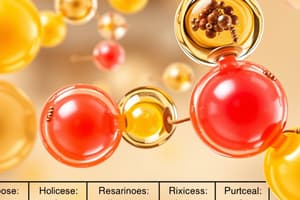Podcast
Questions and Answers
What is the primary cause of rancidity in oils and fats?
What is the primary cause of rancidity in oils and fats?
- Hydrolysis of triacylglycerols
- Microbial growth and spoilage
- Oxidation of fatty acid double bonds (correct)
- Decarboxylation of fatty acids
What is the purpose of adding antioxidants to commercially prepared foods containing fats and oils?
What is the purpose of adding antioxidants to commercially prepared foods containing fats and oils?
- To enhance the flavor
- To improve the texture
- To increase the nutritional value
- To increase the shelf life (correct)
Which of the following is a naturally occurring antioxidant mentioned in the text?
Which of the following is a naturally occurring antioxidant mentioned in the text?
- Phospholipids
- BHA
- Vitamin C (correct)
- BHT
What is the purpose of the phospholipid bilayer in the cell membrane?
What is the purpose of the phospholipid bilayer in the cell membrane?
What is the functional group called when two of the hydrogen atoms in phosphoric acid are replaced by R groups?
What is the functional group called when two of the hydrogen atoms in phosphoric acid are replaced by R groups?
Flashcards are hidden until you start studying
Study Notes
Fatty Acids
- A notation like 18:3(Δ 9,12,15) denotes a C18 PUFA with three double bonds between carbons 9 and 10, 12 and 13, and 15 and 16.
- MUFAs are usually Δ 9 acids.
- The first two additional double bonds in PUFAs are generally at the Δ12 and Δ15 locations.
- Omega-3 fatty acid: an unsaturated fatty acid with its endmost double bond three carbon atoms away from its methyl end.
- Omega-6 fatty acid: an unsaturated fatty acid with its endmost double bond six carbon atoms away from its methyl end.
Physical Properties of Fatty Acids
- Water solubility decreases with increasing carbon chain length.
- Melting points increase with increasing carbon chain length and unsaturation.
Triacylglycerols (TAGs)
- Also known as triacylglycerides, fats, and oils.
- Formed by the esterification of glycerol with three fatty acid molecules.
- Concentrated primarily in adipocytes, found in various parts of the body.
Hydrolysis of TAGs
- Hydrolysis of a triacylglycerol is the reverse of the esterification reaction by which it was formed.
- Results in glycerol and fatty acids.
- Can be acidic or basic.
Types of Triacylglycerols
- Simple triacylglycerol: formed from the esterification of glycerol with three identical fatty acid molecules.
- Mixed triacylglycerol: formed from the esterification of glycerol with more than one kind of fatty acid molecule.
Animal Fats vs Vegetable Oils
- Fats: triacylglycerol mixtures that are solids or semi-solids at room temperature (25°C).
- Oils: triacylglycerol mixtures that are liquids at room temperature (25°C).
Oxidation of Fatty Acids
- The carbon–carbon double bonds in fatty acid residues are subject to oxidation with molecular oxygen.
- Results in aldehyde and carboxylic acid products, leading to rancidity.
- Antioxidants (e.g., vitamin C and vitamin E) can prevent oxidation.
Phospholipids
- Derivatives of phosphoric acid, formed by replacing two H atoms with R groups.
- Assemble in a lipid bilayer when mixed with water, with ionic heads on the outside and nonpolar tails on the inside.
- Form the main fabric of the insoluble barrier that protects the cell.
Studying That Suits You
Use AI to generate personalized quizzes and flashcards to suit your learning preferences.




